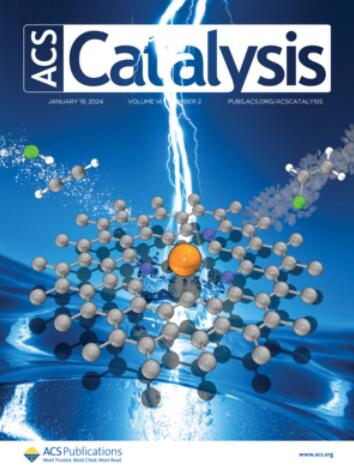Pt-Shell-Protected PtZn Intermetallic Nanoclusters for Highly Efficient Propane Dehydrogenation
IF 11.3
1区 化学
Q1 CHEMISTRY, PHYSICAL
引用次数: 0
Abstract
Propane dehydrogenation (PDH) using platinum-based intermetallic catalysts is an important approach for the industrial production of highly value-added propylene. Nevertheless, the high temperature needed for PDH inevitably causes deactivation of the intermetallic catalysts due to phase separation or particle aggregation. Herein, we showcase that a Pt shell offers a promising solution to protect intermetallics under harsh PDH environments. Through selective removal of the surface Zn atoms, a core/shell architecture with 1–2 atomic layers of Pt coating PtZn intermetallic nanoclusters is constructed. No deactivation was observed within an 80 h long-term stability test at 580 °C on the optimal PtZn/Pt catalyst, affording an extremely low deactivation rate constant of 0.0007 h–1. Furthermore, the construction of the PtZn/Pt core/shell promotes the catalytic efficiency, with a high propylene formation rate of 124.8 mol of C3H6 gPt–1 h–1 that surpasses that of most of the Pt-based PDH catalysts reported. Density functional theory calculations reveal that the Pt shell plays dual roles in stabilizing the intermetallic core and modifying the electronic structure of the ensemble by inducing a compressive strain. This lattice strain downshifts the d-band center to a lower value of −3.02 eV and decreases propylene desorption energy to a level lower than the barrier energy of C–H breaking by 0.66 eV, resulting in enhanced coking resistance and reactivity.

求助全文
约1分钟内获得全文
求助全文
来源期刊

ACS Catalysis
CHEMISTRY, PHYSICAL-
CiteScore
20.80
自引率
6.20%
发文量
1253
审稿时长
1.5 months
期刊介绍:
ACS Catalysis is an esteemed journal that publishes original research in the fields of heterogeneous catalysis, molecular catalysis, and biocatalysis. It offers broad coverage across diverse areas such as life sciences, organometallics and synthesis, photochemistry and electrochemistry, drug discovery and synthesis, materials science, environmental protection, polymer discovery and synthesis, and energy and fuels.
The scope of the journal is to showcase innovative work in various aspects of catalysis. This includes new reactions and novel synthetic approaches utilizing known catalysts, the discovery or modification of new catalysts, elucidation of catalytic mechanisms through cutting-edge investigations, practical enhancements of existing processes, as well as conceptual advances in the field. Contributions to ACS Catalysis can encompass both experimental and theoretical research focused on catalytic molecules, macromolecules, and materials that exhibit catalytic turnover.
 求助内容:
求助内容: 应助结果提醒方式:
应助结果提醒方式:


